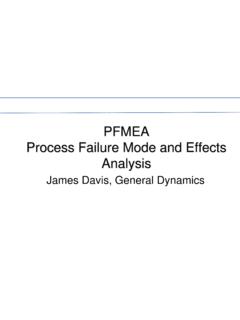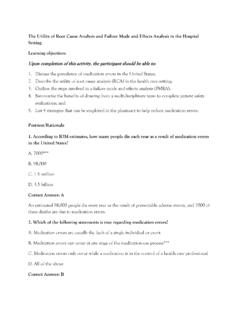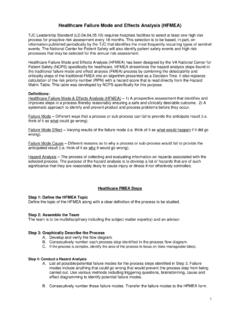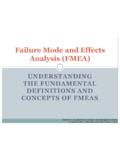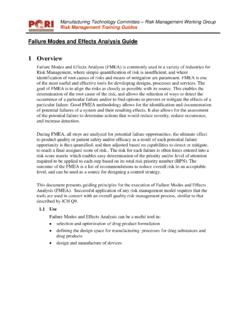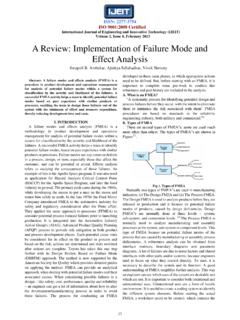Transcription of Failure Modes, Effects and Diagnostic Analysis - …
1 Failure Modes, Effects and Diagnostic Analysis Project: 2088 Pressure Transmitter Customer: Rosemount Inc. Chanhassen, Minnesota USA. Contract No.: ROS 06/10-18. Report No.: ROS 06/10-18 R001. Version V1, Revision R1, October 16, 2006. John C. Grebe - William Goble The document was prepared using best effort. The authors make no warranty of any kind and shall not be liable in any event for incidental or consequential damages in connection with the application of the document. All rights reserved. Management summary This report summarizes the results of the Failure Modes, Effects , and Diagnostic Analysis (FMEDA) of the 2088 Pressure Transmitter.
2 A FMEDA is one of the steps to be taken to achieve functional safety certification per IEC 61508 of a device. From the FMEDA, Failure rates and Safe Failure Fraction are determined. The FMEDA that is described in this report concerns only the hardware of the 2088 Pressure Transmitter, electronic and mechanical. For full functional safety certification purposes all requirements of IEC 61508 will be considered. The 2088 Pressure Transmitter is a two-wire 4 20 mA smart device. It contains self- diagnostics and is programmed to send its output to a specified Failure state, either high or low upon internal detection of a Failure .
3 For safety instrumented systems usage it is assumed that the 4 20 mA output is the safety variable. The device can be equipped with or without display. The 2088 Pressure Transmitter is classified as a Type B1 device according to IEC 61508, having a hardware fault tolerance of 0. The Analysis shows that the device has a safe Failure fraction between 60 and 90% (assuming that the logic solver is programmed to detect over- scale and under-scale currents) and therefore may be used up to SIL 1 as a single device. The Failure rates for the 2088 transmitter are listed in Table 1. Table 1 Failure rates 2088 pressure transmitter Failure category Failure rate (in FIT).
4 Fail Dangerous Detected 351. Fail Detected (detected by internal diagnostics) 258. Fail High (detected by the logic solver) 64. Fail Low (detected by the logic solver) 29. Fail Dangerous Undetected 126. No effect 214. Annunciation Undetected 13. Table 2 lists these Failure rates for the according to IEC 61508. Table 2 Failure rates and SFF according to IEC 61508. Device sd su2 dd du SFF. 2088 pressure transmitter 0 FIT 227 FIT 351 FIT 126 FIT 82%. These Failure rates are valid for the useful lifetime of the product, see Appendix A: Lifetime of critical components. A user of the 2088 Pressure Transmitter can utilize these Failure rates in a probabilistic model of a safety instrumented function (SIF) to determine suitability in part for safety instrumented system (SIS) usage in a particular safety integrity level (SIL).
5 A full table of Failure rates is presented in section along with all assumptions. 1. Type B component: Complex component (using micro controllers or programmable logic); for details see of IEC 61508-2. 2. It is important to realize that the no effect failures are included in the safe undetected Failure category according to IEC 61508. Note that these failures on their own will not affect system reliability or safety, and should not be included in spurious trip calculations exida ros 06-10-18 2088 pressure fmeda v1 , 20-Oct-06. John C. Grebe - William Goble Page 2 of 19. Table of Contents Management 1 Purpose and Scope.
6 4. 2 Project Roles of the parties Standards / Literature Reference Documentation provided by Rosemount Inc..6. Documentation generated by exida ..6. 3 Product Description ..7. 4 Failure Modes, Effects , and Diagnostics Description of the Failure Methodology FMEDA, Failure Failure rates ..9. Assumptions ..9. Results ..11. 5 Using the FMEDA results ..12. Impulse line clogging ..12. PFDAVG calculation 2088 Pressure Transmitter ..12. 6 Terms and 7 Status of the Liability ..14. Releases ..14. Future Release Appendix A: Lifetime of critical components ..15. Appendix B Proof test to reveal dangerous undetected faults.
7 16. Suggested Proof Test ..16. Alternative Proof Test ..16. Appendix C: Common Cause - redundant transmitter configuration ..17. exida ros 06-10-18 2088 pressure fmeda v1 , 20-Oct-06. John C. Grebe - William Goble Page 3 of 19. 1 Purpose and Scope Generally three options exist when doing an assessment of sensors, interfaces and/or final elements. Option 1: Hardware assessment according to IEC 61508. Option 1 is a hardware assessment by exida according to the relevant functional safety standard(s) like IEC 61508 or EN 954-1. The hardware assessment consists of a FMEDA to determine the fault behavior and the Failure rates of the device, which are then used to calculate the Safe Failure Fraction (SFF) and the average Probability of Failure on Demand (PFDAVG).
8 This option for pre-existing hardware devices shall provide the safety instrumentation engineer with the required Failure data as per IEC 61508 / IEC 61511 and does not include an assessment of the development process. Option 2: Hardware assessment with proven-in-use consideration according to IEC 61508 /. IEC 61511. Option 2 is an assessment by exida according to the relevant functional safety standard(s) like IEC 61508 or EN 954-1. The hardware assessment consists of a FMEDA to determine the fault behavior and the Failure rates of the device, which are then used to calculate the Safe Failure Fraction (SFF) and the average Probability of Failure on Demand (PFDAVG).
9 In addition, this option includes an assessment of the proven-in-use demonstration of the device and its software including the modification process. This option shall provide the safety instrumentation engineer with the required Failure data as per IEC 61508 / IEC 61511 and justify the reduced fault tolerance requirements of IEC 61511. for sensors, final elements and other PE field devices. Option 3: Full assessment according to IEC 61508. Option 3 is a full assessment by exida according to the relevant application standard(s) like IEC. 61511 or EN 298 and the necessary functional safety standard(s) like IEC 61508 or EN 954-1.
10 The full assessment extends option 1 by an assessment of all fault avoidance and fault control measures during hardware and software development. This assessment shall be done according to option 1. This document shall describe the results of the hardware assessment in the form of a Failure Modes, Effects , and Diagnostic Analysis (FMEDA) carried out on the 2088 Pressure Transmitter. From this, Failure rates, Safe Failure Fraction (SFF) and example PFDAVG values are calculated. It shall be assessed whether the 2088 Pressure Transmitter meets the average Probability of Failure on Demand (PFDAVG) requirements and the architectural constraints for SIL 2 sub- systems according to IEC 61508.










